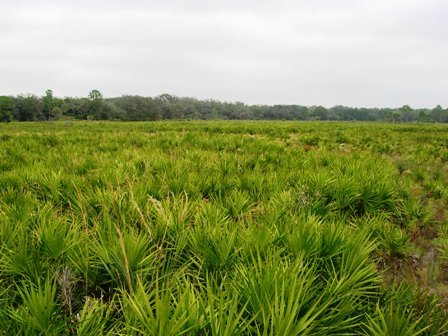Discover Florida Nature
It's time to explore the natural Florida


|
|
|
|
|
|
SUBSTRATE: Relatively poorly drained, acidic, sandy soils. TOPOGRAPHY: Low, flat VEGETATION: Pine flatwoods—overstory of longleaf, slash, or pond pine dominates; shrub understory contains species such as saw palmetto, wax myrtle, gallberry, and wiregrass. Dry prairies—similar to pine flatwoods but lacking pine overstory. FAUNA: Diverse birds, mammals, reptiles, and amphibians are found in pine flatwoods, (e.g., eastern diamondback rattlesnake, threatened red-cockaded woodpecker, white-tailed deer, threatened Florida black bear, endangered Florida panther). Dry prairies are primary habitat of threatened crested caracara and threatened sandhill crane. PROCESSES / DYNAMICS / ABIOTIC FACTORS: Highly transparent, warm, relatively nutrient-poor waters are favorable; terrestrial vegetation, including mangroves along shoreline, filters sediments, organic debris, and nutrients. NEGATIVE IMPACTS: Hurricanes tear reefs apart, and gradually warming waters bleach and weaken corals. Diseases often become a problem for the weakened organisms. Humans pose additional hazards to the reefs by polluting the waters and by the use of poor fishing practices. High nutrient levels such as those found in runoff from agricultural areas can harm reefs by encouraging excess algae growth.  Pinelands,
or pine flatwoods, are the most common plant communities in Florida.
Pinelands are found on nearly level land, or on porous limestone.
Extensive areas of pine flatwoods are found in the panhandle, northeast,
central, and south Florida. The habitat often forms a matrix with other
upland and wetland habitats. Pinelands,
or pine flatwoods, are the most common plant communities in Florida.
Pinelands are found on nearly level land, or on porous limestone.
Extensive areas of pine flatwoods are found in the panhandle, northeast,
central, and south Florida. The habitat often forms a matrix with other
upland and wetland habitats.
Two species of pine trees dominate the modern pine flatwoods. Long-leaf and slash pine are commonly found in the panhandle and north and central Florida while slash pine is the only species that exists in south Florida pine flatwoods. An open canopy allows abundant amounts of sunshine to reach the forest floor. This supports an extensive low growing understory. Dominate species include gallberry, saw palmetto, wiregrass, wax myrtle, fetterbush, and several other grass species. One of the most important elements of the pine flatwoods is fire. Before the extensive development of the state, natural fires started by lightning strikes kept the overstory relatively open, the understory in check and the invasion of hardwoods to a minimum. As a natural part of this habitat, fire helps to recycle nutrients and creates favorable growth conditions for the fire resistant seeds of the flatwood's native grasses and understory plants. Once development began to spread, fire was suppressed, excess fuel accumulated on the ground leading to an increased risk of devastating wild fires, and the species composition of some pine flatwoods changed. Dry prairies are large treeless areas located in Central Florida and are considered endemic to the state. Over 240 plant species have been documented in dry prairie, but they are primarily dominated by low shrubs, runner oak, fetterbush, grasses, and other herbaceous species. Dry prairies closely resemble pine flatwoods without the pine overstory. In fact, dry prairie can be thought of as the endpoint along a forested to treeless continuum of flatwoods/savanna landscapes, in response to variation in the natural fire regime.Dry prairies occur on low, flat topography with poorly drained acidic soil that is subject to flooding for a short duration after heavy summer rains. Although the reason for treelessness remains subject to debate, dry prairies are adjacent to pine flatwoods and scrubby hardwood ecotypes. If fire is kept out of dry prairie ecosystems trees from adjacent ecosystems will invade a dry prairie. The persistence of dry prairie has also been closely tied to cattle ranching that has existed in central and South Florida since European settlement. |
|
|
Advertise | Privacy Statement | Dog Encyclopedia | Video |Contact Alaska Nature| Michael Arnold Art |
|